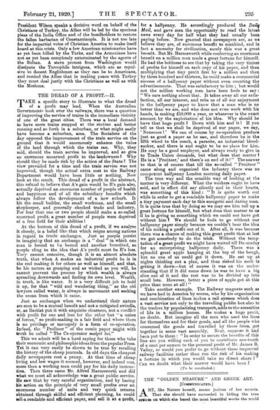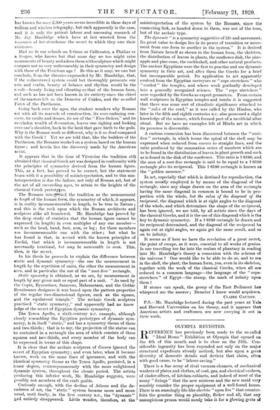THE " GOLDEN MEASURE " AND GREEK ART. [COKKUNICATED.] A RT,
like Nature herself, seems jealous of her secrets. That she should have succeeded in hiding the true argent on which she based the most beautiful works the world
has known for over 2,300 years seems incredible in these days of radium and wireless telegraphy, but such apparently is the case, and it is only the patient labour and unceasing research of Mr. Jay Hambidge which have at last wrested from the treasures of her storehouse the secret to which they owe their existence.
Had we in our schools an Ictinus or Callicrates, a Phidias or a Scopas, who knows but that some day we too might raise monuments of beauty and adorn them with sculpture which might compare not so very unfavourably in their symmetry and design with those of the Periclean age ? Be this as it may, we can but conclude, from the theories expounded by Mr. Hambidge, that, if the rediscovered system could but thoroughly permeate our arts and crafts, beauty of balance and rhythm would be the 1s-suit—beauty living and vibrating as that of the human form, and such as has not been known in its entirety since the chisel of the masters left us the Demeter of Cnidos, and the so-called Fates of the Parthenon.
Going back over the ages, the student wonders why Roman art with all its marvels of construction, its ever-enduring con- crete, its vaults and domes, its use of the " Five Orders," and its overladen wealth of decoration, leaves one sighing and looking over one's shoulder, back to the land that gave birth to the gods. Why is the Roman work so different, why is it so dead compared with the Greek ? Yet we are told that, like the builders of the Parthenon, the Romans worked on a system based on the human figure ; and herein lies the discovery made by the -American artist•.
It appears that in the time of Vitruvius the tradition still obtained that classical Greek art was designed in conformity with the principles of symmetry derived from the human figure. This, as a fact, has proved to be correct, but the statement bears with it a possibility of misinterpretation, and to this mis- interpretation is due the failure, not only of Roman art, but of the art of all succeeding ages, to attain to the heights of the classical Greek prototyyes.
The Romans intelsrated the tradition as the measurement in length of the human form, the symmetry of which, it appears, is in reality incommensurable in length, to be true to Nature ; and this is the rock upon which the Roman architects and sculptors alike all foundered. Mr. Hambidge has Proved by the deep study of statistics that the human figure cannot be expressed (in length) in even multiples of any one member— such as the head, hand, foot, arm, or leg ; for these members are incommensurable one with the other ; but what he has found is that, in accord with the known principles of Euclid, that which is incommensurable in length is not necessarily irrational, but may be measurable in area. This, then, is the secret.
In his thesis he proceeds to explain the difference between static and dynamic symmetry—the one the measurement in length by the repetition of units, the other the measurement in area, and in particular the use of the " root-five " rectangle.
Static symmetry is obtained, as we see, by measurement in length by any given unit or equal part of a unit. "As used by the Copts, Bvzantines, Saracens, Mahometans, and the Gothic Renaissance designers it was based upon the pattern properties of the regular two-dimensional figures, such as the square, and the equilateral triangle." The archaic Greek sculptors practised " static symmetry," and apparently had no know ledge of the secret of Egyptian dynamic symmetry.
The Tenea Apollo, a sixth-century B.C. example, although closely resembling the Egyptian prototypes of dynamic sym- metry, is in itself "static," and has a symmetry theme of three and two-thirds ; that is to say, the projection of the statue can be contained in a rectangle the area of which consists of three squares and two-thirds, and every member of the body can be expressed in terms of this shape.
It is clear that the archaic sculptors of Greece ignored the secret of Egyptian symmetry; and even later, when it became known, work on the same lines of ignorance; and with the identical symmetry theme as the Tenea Apollo, persisted, in a lesser degree, contemporaneously with the more enlightened dynamic system, throughout the classic period. The artists producing this inferior work, Mr. Hambidgo suggests, were possibly not members of the craft guilds.
Curiously enough, with the decline of Athens and tho de- cadence of art-, the " static " system became more and more usual, until finally, in the first century B.C., the "dynamic" had entirely disappeared. Little wonder, therefore, at the
misinterpretation of the system by the Romans, since the connecting link, as handed down to them, was not of the true, but of the archaic type.
The dynamic " is a symmetry suggestive of life and movement. Its great value to design lies in its power of transition or move- ment from one form to another in the system." It is derived from Nature herself as shown in the human form, the skeleton, the distribution of leaves in plants, the sunflower disk, the pine- apple and pine-cone, the cockleshell, and other natural products. The ancient Egyptians were the first to practise and use dynamic symmetry in their art, and after them the Greeks for a brief but incomparable period. Its application to art apparently evolved from the Egyptian surveyors or " rope stretchers " who " corded " the temples, and whose work gradually developed into a generally recognized science. The " rope stretchers " were regarded by the Greeks as expert geometers. From certain wall sculptures in Egyptian temples and tombs it is suggested that there was some sort of ritualistic significance attached to the " rules of the cord," as it was called by the Hindus, who later in the fifth and eighth centuries B.C. also possessed a slight knowledge of the science, which formed part of a sacrificial altar ritual. But we have no examples left of Hindu art in which its presence is discernible.
A curious connexion has been discovered between the "root-
five " rectangle, in which terms the spiral of the shell may be expressed when reduced from curves to straight lines, and the ratio produced by the summation series of numbers which are to be found in the distribution of leaves in plant growth and such as is found in the disk of the sunflower. This ratio is 1.6180, and the area of a root-five rectangle is said to be equal to a 1.6180 rectangle plus its reciprocal. This 1.6180 rectangle is known as the " golden measure."
In art, especially that which is destined for reproduction, the system usually employed is by means of the diagonal of the rectangle, since any shape drawn on the area of the rectangle having the same diagonal in common is bound to be in pro- portion with the whole, but the value of the diagonal of the reciprocal, the diagonal which is at right angles to the diagonal of the whole, and which determines the shape of the reciprocal, has been ignored, we are told, by all artists since the days of the classical Greeks, and it is the use of this diagonal which is the key to dynamic symmetry. If a 1.6180 rectangle be drawn and its reciprocal determined, and the diagonal of the reciprocal be again cut at right angles, we again get the same result, and so on to infinity.
It seems as if here we have the revelation of a great secret, the point of escape, as it were, essential to all works of genius. Is one travelling too far into the realms of phantasy in reading into Mr. Hambidge's theory a connexion with the scheme of the universe ? One would like to be able to do so, and to see in the shell, the plant, the human form, yea, even in its skeleton, together with the work of the classical Greeks, when all are reduced to a common language—the language of the " rope- stretchers " of Egypt—the stamp, the mark of infinity upon them !
If stones can speak, the group of the East Pediment has whispered me the answer ; Demeter I know would acquiesce. CLAIRE GAIIDET. P.S.—Mr. Hambidge lectured during the past years at Yale and Harvard Universities on his theory, and it appears that American artists and craftsmen are now carrying it out in their work.



































 Previous page
Previous page